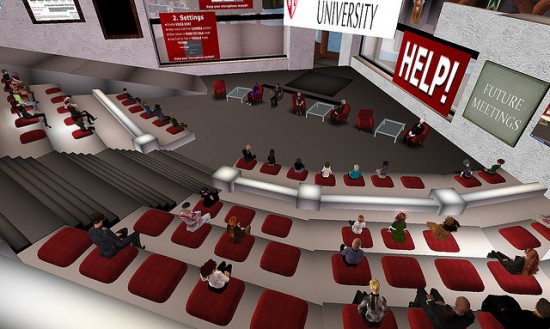The good folks at the Virtual Worlds Education Roundtable are training new people to host our meetings, and they’ve asked us veterans to share our ideas.
The following  principles have worked fairly well for me over the past few years.

1. Open forums are not completely open
When I host one of these, I let the crowd set the flow of the conversation, but I begin with a question such as “so, what news, ideas, or issues about virtual worlds would the group like to discuss?” I have a fall-back topic if everyone is sitting on their virtual hands. This week I’d say “So could virtual pets be of any use in education?” and let the crowd take it from there.
2. Expect some chaos, but rein in the digressions
I don’t mind a bit of off-topic talk, given the nature of synchronous text chat. It tends to be multi-threaded. But if a digression starts to become the dominant topic, I’ll come back with something like “let’s get back to XYZ’s question about lag in the latest SL Viewer.” I’ll even IM those digressing, if it gets bad enough and someone complains to me in IM.
3. Topical forums need a “pump primer”
I learned this in the 90s with Daedalus Interchange in my writing classes. The moderator will start the group with an initial issue or question, then let them run with it. In this transcript, about machinima, I began with ” how many of you have made machinima? Answer yes or no.” That’s great for establishing a knowledge base, but it’s not enough. I followed up with “To those who answered “yesâ€: What is the one resource (aside from SL) that you like best when making machinima? Add URLs if you have them.” This really gives the transcript some “meat” for those who are not present or who wish to consult it later when making their next machinima.
4. You can send one or two questions out in advance
I don’t often do this, but on occasion I will send a note in-world and to the e-lists with advice such as “Come prepared to share your favorite site for education in virtual worlds and to tell us why.”
5. Get the crowd to keep the talk flowing
In both sorts of meetings, I either ask a follow-up question such as “so XYZ, how did your students like entering Second Life through the New Media Consortium’s portal?” or one that gets everyone to reply, such as “can we share one tip for making effective machinima?” These tactics make participants feel acknowledged and lets them do some of the moderator’s work. As much as possible, I want everyone at the meeting to chat. I’m a big-mouth and a fast typist. This tactic helps shut me up.
6. Recap.
Early on in the meeting, I often will sum up the points made. As with #2, I learned this from AJ. I might say “So far, people are saying they prefer chocolate, vanilla, and butter-pecan. What flavors did I miss?”
7. Watch the time
Several moderators remind the group when we have 30 minutes left, 15, and then 5. These points are great for forming up an unruly herd of cats. At the 15 and 5 minute points, I often ask “so what issues have we not covered yet?”
8. Go easy on ban and eject
I’ve done it but rarely. Instead, a temperate IM to someone causing grief can work. I might say “Do you really mean that? It could greatly offend some here” or (black hat on my head) “That remark really offended some of the folks here. Please be a little more temperate.”
I am thrilled that we have a new group of moderators. Running a virtual meeting is a specialized craft. I wish our new moderators luck!
(Article adapted with permission from In a Strange Land.)
- 5 lessons from 6 years of virtual world teaching - May 1, 2013
- The Sweet Smell of Desperation - March 15, 2013
- An educator looks at Cloud Party - June 21, 2012
